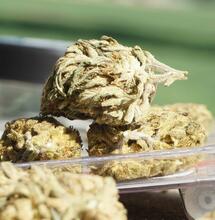Indica, Sativa and Ruderalis

This Original Afghani #1 from 1978 had reddish stigmas, but more often this variety would have white stigmas.
This Original Afghani #1 from 1978 had reddish stigmas, but more often this variety would have white stigmas.
This Original Afghani #1 from 1978 had reddish stigmas, but more often this variety would have white stigmas.
Induce sativa and indica varieties and crosses to flower in greenhouses and indoors by giving plants more hours of total darkness and fewer hours of light. Outdoors, cannabis will flower when it receives 12 hours or more of darkness daily. Give cannabis 12 hours of uninterrupted darkness and 12 hours of light to induce visible signs of flowering in two weeks or less. This program is effective in all but the latest blooming pure sativa varieties.
Small buds are developing on this Chocolope clone two weeks after inducing flowering with a 12-hour photoperiod.
Medicinal cannabis gardeners with a vegetative room illuminated 18-24 hours a day and a flowering room or greenhouse with 12-hour days and 12-hour nights, create environments that mimic the photoperiod in spring and fall. With this simple combination a crop can be harvested every six to ten weeks. In warm southern climates or with the help of artificial light, the harvest can last all year.
Plants show sex, male or female flowers, during the pre-flowering stage which actually occurs during vegetative growth, but it is described below. Once the sex of the plant is established, males unless used for breeding, are harvested before they shed pollen, and females are coaxed into higher yields. Once the photoperiod is set, disrupting it can cause plants to suffer stress. If they suffer enough stress, intersex (hermaphrodite) tendencies increase. Water intake of flowering plants is usually somewhat less than in the vegetative stage. Adequate water during flowering is important for plants to carry on internal chemistry and cannabinoid production. Withholding water to “stress” a plant will actually stunt growth and diminish yield.
Pure Sativa cannabis has its origins in tropical regions. These varieties are accustomed to 12-hours of sunlight and equal darkness all year round. The climate is such that they have a long and temperate growing season with leisurely and consistent growth. Super intense sunlight can be difficult for them to assimilate. Many tropical sativa varieties grow under the shade of the jungle canopy. Indoors, gardeners often give pure tropical sativas too much light. The result is even smaller and lighter flower buds. Lamps set further away or use lower wattage that produce less intensity and heat. Plants do not get as hot and receive adequate light to grow big flower buds.
Give pure sativas more darkness and less light to induce flowering. Give pure tropical sativas 11 or 12 hours of light and 13 or 12 hours of darkness to induce flowering. Some gardeners go so far as to gradually decrease daylight hours to 10 daily with 14 hours or more of darkness. Such practices simulate native climates which gives plants a chance to express their genetics. This technique will promote bigger flower buds.
Auto-flowering cannabis ruderalis varieties do not require long nights to flower. C. ruderalis starts to flower within a month of germinating. Many auto-flowering cannabis ruderalis varieties are ready to harvest 70 days after planting and produce up to 4 ounces (112 gm) of dried medicinal flower buds when grown properly. European breeders have feminized many auto-flowering varieties. To date, the top varieties produce 3-3.5 ounces (80-100 grams) in 70-80 days.
Different Flowering Light/Dark Schedules
- 12/12 – standard day/night schedule for most plants
- 12/12 – switch to 11/13 after one week and 10/14 after two weeks. This is the schedule for tropical sativa varieties like Haze.
- 12/12 – flower for three weeks then increase light to 11/13. Flowering is prolonged but harvest is increased. Note: often indica-dominant varieties flower about the same.
- 24 hours – flowering regime for daylight-neutral C. ruderalis crosses with C. indica and C. sativa.
Note: See “Photoperiod” in Chapter 17, Light, Lamps and Electricity for more detailed information on indica, sativa and ruderalis varieties and flowering.
Stress and Sex
If the photoperiod bounces around it causes plants to suffer stress. Make sure the timer works properly and inspect periodically.
A tiny male flower can be seen on this little female flower cluster. The male flower appeared after low temperatures caused the plant to suffer stress.
Bouncing the photoperiod around and dynamically raising or lowering the temperature has the effect of producing more male plants. I recently spoke to a gardener that induced male flowers on a female plant by lowering the nighttime temperature (normally 70º F [21º C) to 60º F (15º C) for two weeks.
Note: Each stimulus – temperature, photoperiod, etc. – creates a climate that causes plants to suffer stress. And, the stressful environment does not necessarily turn the entire plant male. Most often a few hard-to-spot male pollen sacks appear sporadically on a few branches. The most susceptible plants already have a predisposition to intersexuality.
There are several ways to promote male or female plants during seedling growth. The most dependable way to deduce sex is “Cloning for Sex”.
Do not remove large fan leaves to allow more intense light to reach small buds or to stress plants! Large leaves are packed with food for the plant! They are essential to plant health and vitality. Indoors and in greenhouses where the hours of darkness are controlled, cannabis flowers for six to ten weeks or longer. This is a very short time. Hacking off foliage – leaves and branch tips – to initiate more budding sites is somewhat effective. Most of the lower leaves supply the roots and upper leaves supply energy to the top and promote flower growth. Remove only leaves that are more than 50 percent damaged by diseases, pests, and cultural practices. For example the yellow leaves hanging straight down should be removed.



